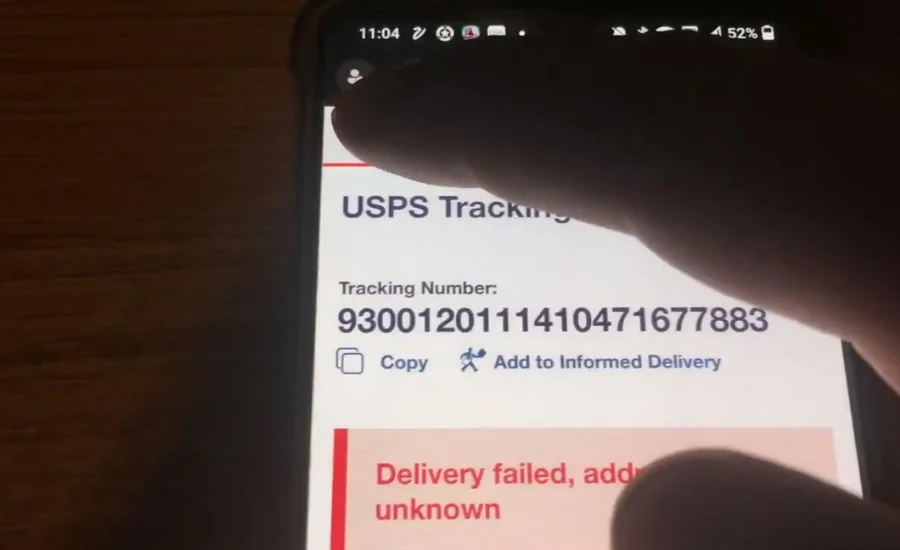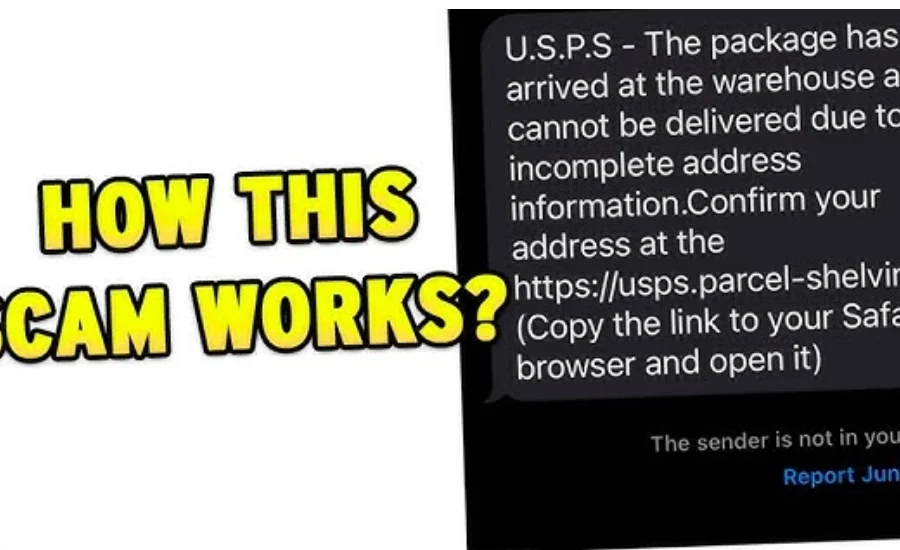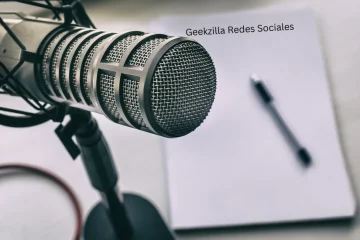A recent phishing scheme poses as the US Postal Service (USPS) in order to deceive gullible Americans. This scam notifies victims by SMS and emails of a purportedly missed parcel delivery, along with a phony tracking number (9300120111410471677883) that seems real. The notice asks readers to click on a link in order to fix the delivery problem.
But clicking on this link will take you to a fraudulent USPS website designed to steal credit card and personal data. Scammers utilize the information that users enter to steal identities or sell it online, which results in financial crimes like billing fraud. Thousands of people across have already fallen victim to this massive fraud.
In this article, we will delve into the details of the sophisticated USPS scam involving tracking number 9300120111410471677883. We will break down the initial scam notification and examine the convincing fake USPS website. Additionally, we will provide crucial advice on what to do if you fall victim to this scam.
Join us as we explore why this scam has effectively deceived so many Americans, resulting in substantial financial losses for its victims.
Overview of the USPS Package Delivery Scam: Tracking Number 9300120111410471677883

An email, text message, or telephone purporting to be from the USPS is the first sign of this phishing scam. This notification tells you that an erroneous or inadequate shipping address prevented the delivery of a shipment that was intended for you.
Scammers use a phony USPS tracking number, like 9300120111410471677883, that mimics real USPS tracking numbers in order to give their scheme more legitimacy. This particular aspect contributes to the scam’s legitimacy.
The message urges you to click on a link to verify or update your address information to facilitate the redelivery of your “package.” However, this link directs you to a phishing website that is expertly crafted to mimic the real USPS site.
The identical tracking number and an error notice claiming that the delivery failed due to an unknown addressee can be seen on the phony website. When you continue, the website asks for personal information such your name, address, and phone number in order to “schedule a redelivery.”
Actually, the con artists are pursuing your personal data with the intention of either selling it on the illicit market or using it for identity theft. More than 10,000 people in the US have already fallen prey to this extensive fraud, which has destroyed credit, drained bank accounts, and compromised identities.
Let’s examine how victims are tricked by this intricate USPS parcel delivery scam at every turn and what you can do to be safe.
Is 9300120111410471677883 a Genuine USPS Tracking Number?
No, the tracking number 9300120111410471677883 is not a legitimate USPS tracking number. It is a fabricated number created by scammers to facilitate a phishing scam that impersonates the USPS.
Here’s why this tracking number is fraudulent:
- No Real Package: This tracking number is not linked to any actual package or delivery. Scammers generate such numbers to make their messages appear credible.
- Data Theft Intent: Communications containing this tracking number are designed to steal personal and financial information from unsuspecting victims.
- Fake Appearance: Despite how official it may seem, 9300120111410471677883 is entirely fake.
- Tracking Number Formats: Real USPS tracking numbers can vary in format. Simply seeing a number does not confirm its legitimacy.
How to Identify the 9300120111410471677883 USPS Scam
This scam is quite sophisticated, but there are several key indicators that can help you recognize and avoid it:
- Unexpected Packages: Be cautious of any messages about delivery failures if you are not expecting a package or haven’t ordered anything recently.
- Generic Greetings: Scam messages often use generic greetings like “Dear customer” instead of addressing you by name, which is a common red flag.
- Urgency and Pressure: These messages typically create a sense of urgency, urging you to act immediately to reschedule your delivery. This pressure is intended to make you click without thinking.
- Suspicious Links: The links provided in these messages usually lead to unfamiliar websites rather than the official USPS site. Look out for URLs that use variations of “USPS” to appear legitimate.
- Strange Sender Addresses: Scam emails often come from non-official email addresses rather than valid @USPS.gov accounts.
- Requests for Personal Information: The real USPS will not ask you to enter sensitive personal data online to resolve delivery issues. Any such request should be viewed with suspicion.
- Poor Grammar and Spelling: Many scam messages contain typographical errors, grammatical mistakes, and other writing issues, which are signs of a fraudulent communication.
- Repeated Scam Attempts: After the initial contact, scammers might send more messages or make calls trying to get you to provide personal information.
Key Takeaway

The most critical sign of this scam is the pressure to click questionable links and provide sensitive information to resolve a supposed delivery problem. If you receive any message,then do not click on any links. Instead, contact USPS directly using a verified phone number to confirm any real delivery issues. Always avoid interacting with links in unsolicited messages claiming to be from USPS.
Understanding the 9300120111410471677883 USPS Scam
The 9300120111410471677883 USPS scam uses urgency, plausibility, and sophisticated technical tricks to deceive recipients into providing their personal information. Let’s break down how this scam unfolds and what victims encounter at each stage.
Stage 1: The Initial USPS Scam Notification
The scam typically begins with a text message, email, or voicemail that appears to come from the USPS. Scammers use spoofing technology to make it seem like these messages originate from legitimate USPS phone numbers and email addresses.
A typical scam message might look like this:
Notification from USPS: A package designated for your address has been returned to our facility due to an incomplete address.Please click here to verify your address for redelivery: [malicious link]
The message creates a sense of urgency about resolving the address issue to ensure the package is delivered promptly. The tracking number, 9300120111410471677883, adds to the message’s credibility because it mimics a real USPS tracking number.
Given the prevalence of online shopping and package deliveries, recipients might easily believe the message is legitimate and click the link without further scrutiny.
Stage 2: Redirected to a Fake USPS Site
Clicking the link takes recipients away from the official USPS website to an elaborate phishing site designed to look like the real USPS site.
The fake site closely mimics the USPS homepage, including design elements, images, branding, and menus. However, the URL will be slightly different, such as USPS-secure365.com or USPS-service.com, which can be hard to notice.
On the phishing site, victims see the fake tracking number prominently displayed alongside a message like:
Tracking Number: 9300120111410471677883
Delivery failed, addressee unknown
Your item was delivered at 11:22 am on October 16, 2023, in [your location]. But you are not at the shipping address or don’t have a safe place to store it temporarily.
This message reinforces the illusion of a legitimate delivery issue, convincing victims that verifying their address will resolve the problem.
Stage 3: Prompted to Enter Personal Information
Next, victims are directed to a page asking them to confirm or update their address to “schedule a redelivery.” This page mirrors the real USPS site’s design, including fonts, colors, logos, and navigation bars.
Victims are prompted to enter:
- Full name
- Street address
- City
- State
- ZIP code
- Phone number
All fields are marked as required. Once victims provide their details, scammers immediately gain access to their personal information, enabling identity theft, fake tax filings, and more.
Some fake sites even ask for credit card information to cover a small redelivery fee, typically around $0.30. This gives scammers access to credit card numbers, expiration dates, CVC codes, and billing addresses, allowing them to commit billing fraud.
Stage 4: Exploiting Stolen Data
After victims submit their information, scammers use it to profit in several ways:
- Selling Data: Personal information is sold on the black market, fetching high prices on underground forums.
- Identity Theft: Scammers use the data to open credit cards, bank accounts, or file fake tax returns.
- Extortion: Victims might be contacted with ransom demands to prevent their information from being leaked.
- Future Scams: With the victim’s contact details, scammers can target them with more personalized phishing attempts in the future.
Victims must take immediate action to secure their information after falling for this effective USPS package delivery scam.
What to Do If You Entered Personal Information on a Fake USPS Site
If you’ve accidentally submitted your personal data through a fraudulent USPS site, it’s crucial to act quickly to protect yourself. Here are the steps you should take immediately:
Step 1: Contact Financial Institutions
If you disclosed any financial information, such as credit card or bank account numbers, get in touch with your credit card and bank companies right once. Tell them you could be a victim of fraud so they can keep an eye on your accounts for any unusual behavior and, if needed, freeze your access.
Step 2: Place Fraud Alerts
Reach out to one of the three major credit bureaus—Experian, Equifax, or TransUnion—to place a fraud alert on your credit file. This alert makes it more difficult for criminals to open new accounts in your name. Once you place an alert with one bureau, they will share it with the other two.
Step 3: Monitor Credit Reports
Regularly check your credit reports from all three credit bureaus for any unusual activity. Initially, scrutinize these reports daily to catch any illegal activity as soon as it occurs. This vigilance can help you detect and address fraud quickly.
Step 4: Change Online Passwords
If you used the same password on the fake USPS site as on any other accounts, change it immediately across all platforms. Going forward, use strong, unique passwords for each of your accounts to enhance security.
Step 5: File Reports
Report the identity theft to the Federal Trade Commission (FTC) and your local police department. Provide them with detailed information about the scam to help with their investigations.
Step 6: Watch for Additional Scams
Be extra cautious with any calls, emails, or texts that ask for your personal information. Scammers often target previous victims with new scams, assuming they are more vulnerable.
Step 7: Consider Credit Freezes
For maximum protection, you might want to freeze your credit files with the three major credit bureaus. This action limits access to your credit reports, making it more difficult for criminals to open new accounts in your name. You can temporarily lift the freeze when you need to apply for legitimate credit.
Recovering from Identity Theft
Recovering from identity theft can be a lengthy and challenging process, but acting quickly will give you the best chance to secure your accounts and minimize damage after falling victim to the 9300120111410471677883 USPS scam. Stay vigilant and proactive in monitoring your financial and personal information.

The Bottom Line
The 9300120111410471677883 tracking number USPS scam highlights the alarming sophistication of modern phishing tactics. Scammers are increasingly capable of spoofing official USPS contacts and creating convincing replica websites, demonstrating their growing technological prowess.
Despite their advanced methods, these scams still heavily rely on eliciting an emotional response from victims. They create a sense of urgency about a delivery issue, pressuring recipients to click a link without careful consideration. This emotional manipulation often overrides critical thinking, allowing the scam to succeed.
Given the prevalence of package deliveries today, this scam appears plausible to many. However, understanding the deceptive techniques at each stage can empower you to recognize and avoid falling victim. By dissecting the scam’s progression—from the urgent notification to the fake tracking data—you can pinpoint the critical moment when personal information is at risk.
Criminals only need small pieces of information to wreak havoc. They can access your accounts, sell your identity online, or extort money through escalating demands. Following the steps outlined above can help victims regain their security after falling prey to this scam.
To protect yourself:
- Analyze any USPS communications carefully.
- Avoid clicking on unverified links.
- Monitor your accounts proactively.
By staying vigilant and informed, you can defend against one of the most widespread and damaging digital frauds threatening Americans today.
How to Identify the 9300120111410471677883 USPS Scam
Despite the sophistication of the 9300120111410471677883 USPS scam, there are several telltale signs that can help you recognize and avoid it:
- Unexpected Package Alerts: Be cautious if you receive delivery failure notifications for packages you aren’t expecting or haven’t ordered.
- Generic Greetings: Scam emails and texts from USPS typically use generic greetings like “Dear customer” instead of addressing you by name.
- Urgency and Pressure: These messages often create a sense of urgency, urging you to act immediately to reschedule your delivery. This pressure is meant to make you click the link without careful consideration.
- Suspicious Links: Check the links in the message carefully. Scam links often lead to unfamiliar sites instead of the official USPS.com. They may include slight variations of “USPS” to appear legitimate.
- Unusual Sender Addresses: Scam emails usually come from non-official email addresses rather than valid @USPS.gov accounts.
- Requests for Personal Information: The real USPS will never ask you to enter sensitive personal data online to fix delivery issues. Any such request should be a red flag.
- Poor Grammar and Spelling: Many scam messages contain typographical errors, grammatical mistakes, and other writing issues, which can indicate fraud.
- Follow-Up Scam Attempts: After the initial contact, scammers might send more messages or make calls trying to get you to provide personal information.

You may also like: WorldWideScienceStories
Final Words
In summary, the 9300120111410471677883 USPS scam is a concerning example of sophisticated phishing tactics targeting unsuspecting Americans. Despite its intricacy, recognizing key indicators such as unexpected package alerts, generic greetings, and suspicious links can help individuals avoid falling victim. By staying vigilant and proactive, individuals can protect themselves from the financial and personal harm caused by these deceptive schemes. It’s crucial to analyze communications carefully, avoid clicking on unverified links, and monitor accounts regularly to mitigate the risk of falling prey to such scams.
For more news and more updates vsite our site Alevemente



